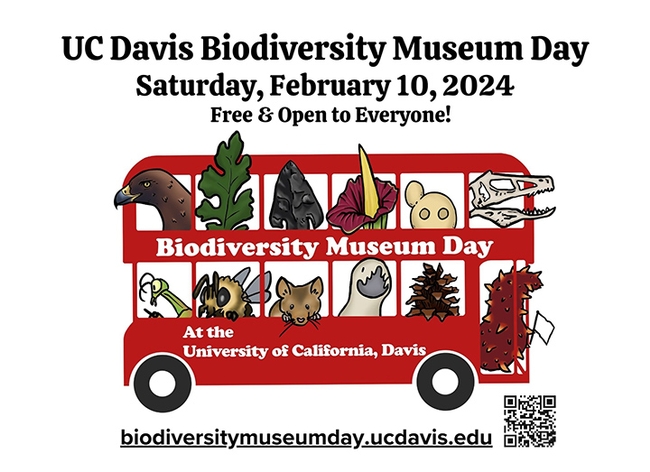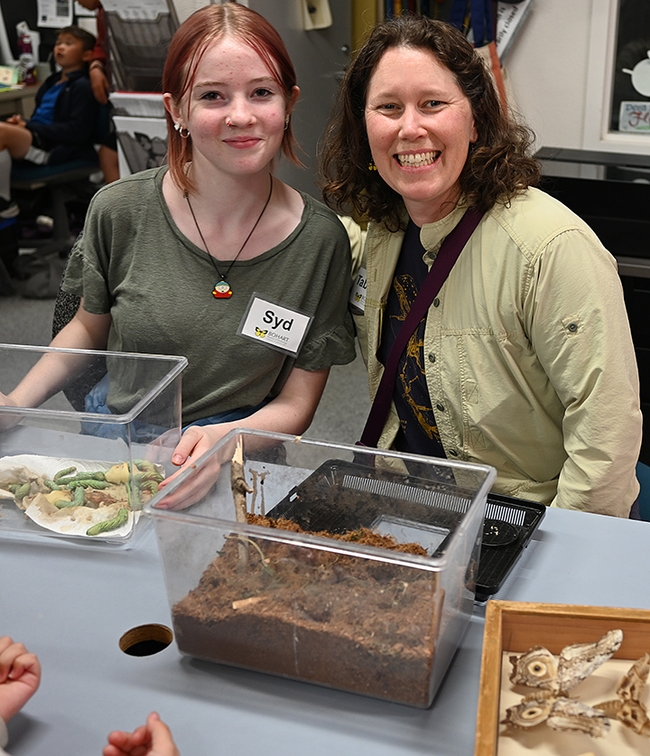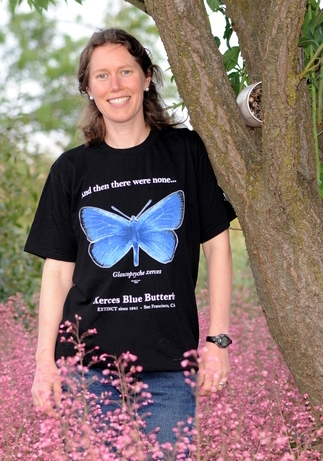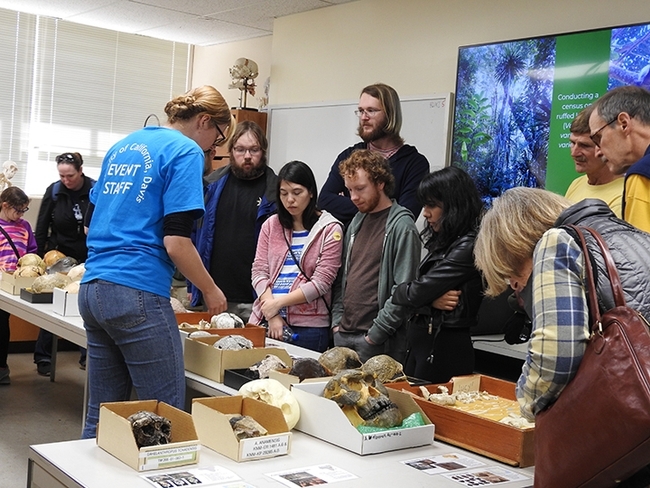- Author: Kathy Keatley Garvey
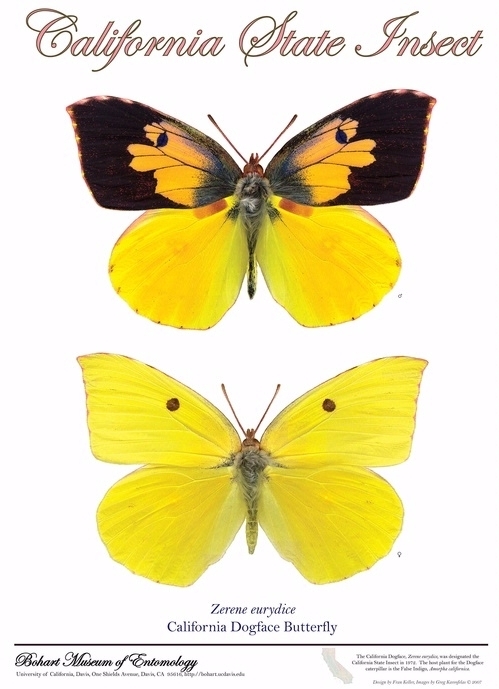
Did you know that California has a state insect? It does.
Is it the honey bee? No.
Is it the lady beetle (ladybug)? No.
Bumble bee? No.
It's the California dogface butterfly (Zerene eurydice), an insect found only in California.
The state Legislature designated it as the state insect in 1972. The butterfly is nicknamed "dogface" in reference to the silhouette of what resembles a poodle head on the wings of the male. The female is mostly solid yellow except for a single black spot on its upper wings.
Most people have never seen it in the wild. But if you've visited the Bohart Museum of Entomology at UC Davis, home of a global collection of 8 million insect specimens, you know that its logo is the California dogface butterfly.
And on Thursday, Aug. 8 those attending the Vacaville Museum Guild's Annual Children's Party (sold out) will see specimens from the Bohart Museum, as well as macro images of the butterfly, the work of talented Bohart associate Greg Kareofelas of Davis.
Tabatha Yang, education and outreach coordinator of the Bohart, has donated a drawer of the specimens for visitors to see. They can also pose in a cutout of the Bohart Museum's California dogface butterfly banner. And thumb through a 35-page children's book, "The Story of the Dogface Butterfly," written by UC Davis doctoral alumna Fran Keller, a professor at Folsom Lake College and a Bohart Museum research scientist. The book includes images by Kareofelas and Keller. Laine Bauer, then a UC Davis student, contributed the illustrations.
The book, published in 2013, tells the untold story of the California dogface butterfly, and how schoolchildren became involved in convincing the State Legislature to select the colorful butterfly as the state insect. Fourth grade students of Betty Harding and Shirley Klein, Dailey Elementary School, Fresno, advocated it as the state insect. The teachers and students enlisted the help of State Assemblyman Kenneth L. Maddy, who authored AB 1834. On July 28, 1972, Governor Ronald Reagan signed the bill into law, designating the California dogface butterfly the official "State Insect of California." (Read more on how the butterfly became the state insect under the Ronald Reagan administration.)
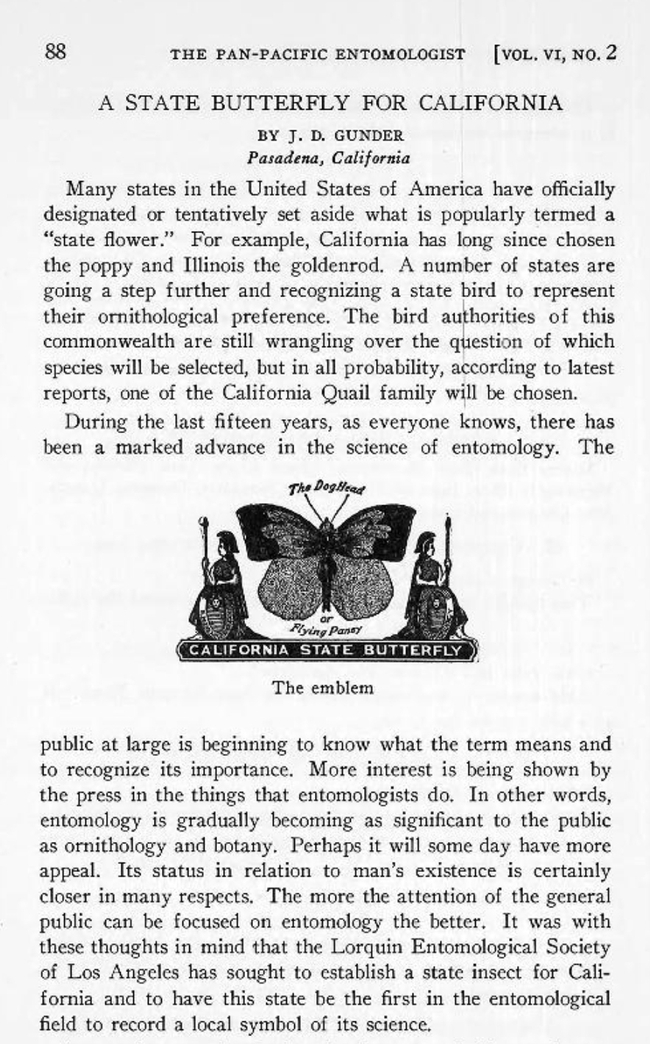
The most prevalent habitat of the California dogface butterfly is the 40-acre Shutamul Bear River Preserve near Auburn, on a Placer Land Trust conservation site; Kareofelas serves as a docent on the Placer Land Trust tours. (See virtual tour on YouTube). The butterfly is there because its larval host plant, false indigo (Amorpha californica), is there.
Are there dogface butterflies in Vacaville? Yes. The butterfly's breeding grounds include Gates Canyon. (See UC Davis emeritus professor Art Shapiro's website.)
As mentioned, few people see the butterfly in the wild. However, its image graces a first-class U.S. stamp and California driver licenses. It's also depicted on the California State Fair monorail.
Butterfly Poster and Book. The Vacaville Museum Guild's Children's Party (see what's on tap) also will spotlight a Bohart Museum poster by Kareofelas-Keller that depicts the male and female butterfly. (Both the poster and the book are available for sale in the Bohart gift shop; net proceeds benefit the insect museum's education, outreach and research programs.)
The Bohart Museum, located in Room 1124 of the Academic Surge Building, 455 Crocker Lane, also houses a petting zoo (featuring stick insects, Madagascar hissing cockroaches and tarantulas) and a insect-themed gift shop, stocked with books, posters, t-shirts, hoodies, jewelry and collecting equipment. Director of the insect museum is Professor Jason Bond, the Evert and Marion Schlinger Endowed Chair, UC Davis Department of Entomology and Nematology, and associate dean, Agricultural Sciences, UC Davis College of Agricultural and Environmental Sciences.
The Bohart is open for walk-in visitors on Tuesdays from 9 a.m. to noon and from 1 to 4:30 p.m. through Aug. 27. It will be closed to the public Sept. 1-22.
The next open house is set for 1 to 4 p.m., Saturday, Sept. 28. The theme is "Museum ABC's: Arthropods, Bohart and Collecting." All open houses are free and family friendly. Parking is also free. For more information, contact bmuseum@ucdavis.edu or access the website at https://bohart.ucdavis.edu.
Links:
- Golden Year for the California Dogface Butterfly (Bug Squad post, Feb. 4, 2022)
- Rob on the Road, KVIE, Public Broadcasting Service (PBS) (First aired July 7, 2017)
- Capital Public Radio Piece on Dogface Butterfly (featuring Greg Kareofelas)
- Pacific Land Trust website (PLT maintains a conservation site in Auburn that's the home of the California dogface butterfly)
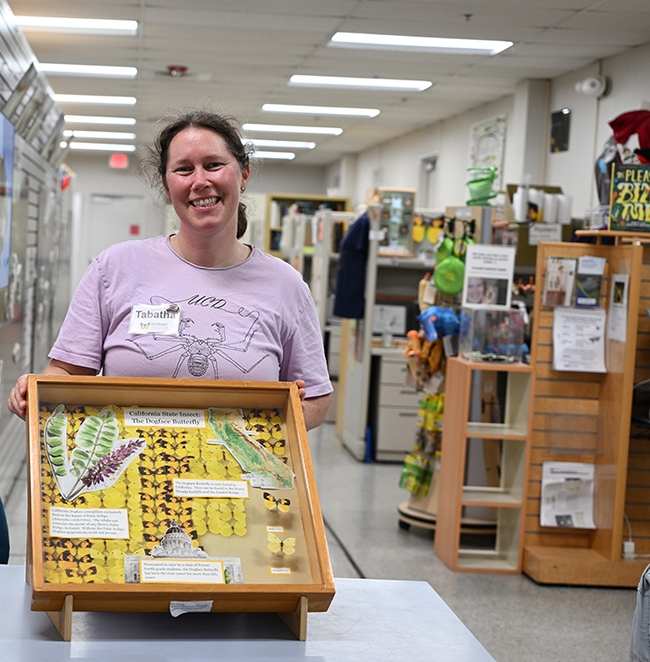
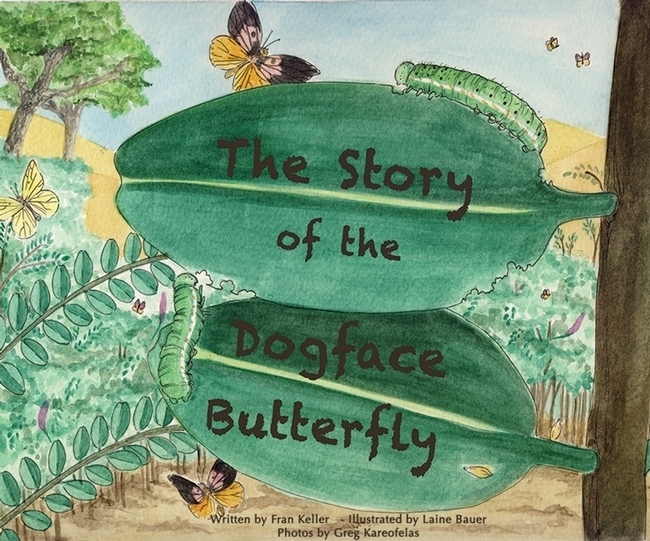
- Author: Kathy Keatley Garvey
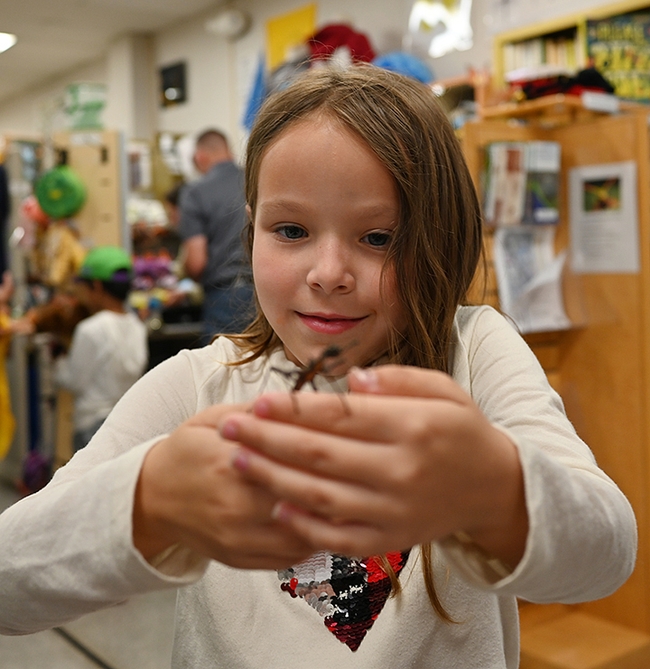
"For me, at least a lot of my interest developed when my parents gave me a net and a butterfly picture book and then gave me enough independence to explore on my own," recalls UC Davis distinguished professor emerita Lynn Kimsey, who served 34 years as director of the Bohart Museum of Entomology before stepping down on Feb. 1.
"Today parents seem to schedule every minute of their kid's day with scheduled activities," Kimsey said, "and this simply doesn't allow kids to explore, and use their imaginations."
So true. Kids are naturally curious. When they see lady beetles, aka ladybugs, they check out what they're doing, what they're eating (a menu of aphids and other soft-bodied insects), and how they take flight.
You can ask them questions: What do you think that is? What is it doing? Can you describe it? Do you want it to be your friend? Why or why not? Do you want to write a poem about it? Do you want to photograph it?
They quickly learn that everything eats in the garden. They can watch a honey bee foraging for nectar and pollen, and then get nailed by a praying mantis. Ditto the butterfly. One minute a butterfly is sipping nectar, and the next minute, it's snared in a spider web.
And they never forget metamorphosis: how a butterfly egg magically transforms into a caterpillar, the caterpillar into a chrysalis, and then an adult butterfly ecloses from that chrysalis. "Magic" and "miracles" occur right before their eyes!
A great example of the natural curiosity of children occurs every year on the UC Davis campus during the "Take Your Daughters and Sons to Work." Mom and Dad show youngsters where they work, and also visit other workplaces. One of the highlights is the Bohart Museum of Entomology
For the Bohart Museum staff and volunteers, it's a good opportunity to engage in science communication or sci-com. Tabatha Yang, education and outreach coordinator organizes the open houses and leads the team. At the recent event, the science communicators included doctoral student Em Jochim of the Jason Bond lab, UC Davis Department of Entomology and Nematology; Oliver Smith, a UC Davis entomology student; psychology major Naomi Lila of the UC Davis Entomology Club; Syd Benson, a high school intern from Met Sacramento; and animal biology major Jakob Lopez wearing a quite appropriate "Have a Nice Day" shirt.
Everly Puckett, 3, was there with her father, Ryan Puckett with Facilities Management. She wasn't sure she wanted to hold any insects (Madagascar hissing cockroaches and stick insects) from the petting zoo but her dad encouraged her to touch a stick insect, aka walking stick.
Ten-year-old Mark Blankenship eagerly held a thorny stick insect. His dad, Mark Blankenship, works for Supply Chain Management.
Eight-year-old Hunter Baker was super interested in the insects and wanted to know more about them. His mother, Kate Schaul, works in security at the UC Davis Library.
Sebastian Carrasco, 3, whose mother Nadia works in UC Davis Health, attended with his father, Lizandro. When asked if he wanted to hold an insect, Sebastian hid behind his father. Then he shook his head and said "Bye, Bye!" to the insect. Clever and creative!
Daphne Shuman, 7, whose mother Amy Shuman, works for Students Affairs, loved the Bohart Museum. In fact she loved it so much she attended the event twice, in the morning and in the afternoon.
Mark Blankenship, 10, peered closely at a stick insect crawling on a hand. His father, Mark, works for Supply Chain Management.
Atlas Scott, 4, attended with his mother Danielle Hoskey who works for UC Davis Health. He decided he'd rather not become acquainted with the stick insects, but he did hold a tomato hornworm.
Bottom line: they will all remember that day at the Bohart Museum, a day when they were encouraged to look, touch and hold an insect.
And, quite likely, many may enroll in college entomology courses and some may seek entomology as a career.
The Bohart Museum, home of a global collection of eight million insect specimens (plus a gift shop and petting zoo), is located in Room 1124 of the Academic Surge Building, 455 Crocker Lane. Summer walk-in hours are Tuesdays, June 17-Aug, 27, 9 a.m. to noon, and 1 to 4:30 p.m. The museum will be closed to the general public from Sept. 1-Sept. 22.
Director is Professor Jason Bond, the Evert and Marion Schlinger Endowed Chair in the Department of Entomology and Nematology. He's also associate dean of agricultural sciences for the College of Agricultural and Environmental Sciences
The next open houses are:
Saturday, July 20: Moth Night at the Museum (inside and outside activities) 7 to 11 p.m.
Saturday, Sept. 28: Museum ABC's: Arthropods, Bohart and Collecting, 1 to 4 p.m.
All open houses are free and family friendly. Parking is also free. For more information, contact the Bohart Museum at bmuseum@ucdavis.edu. or call (530) 752-0493.
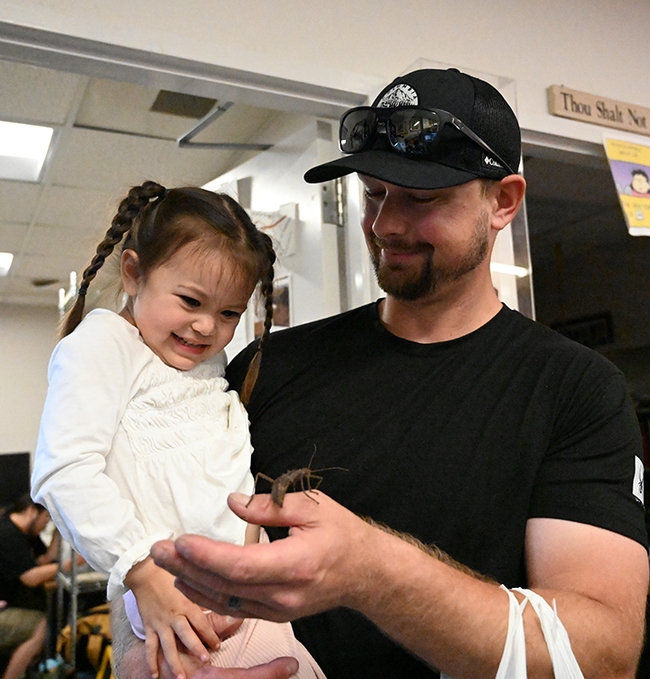
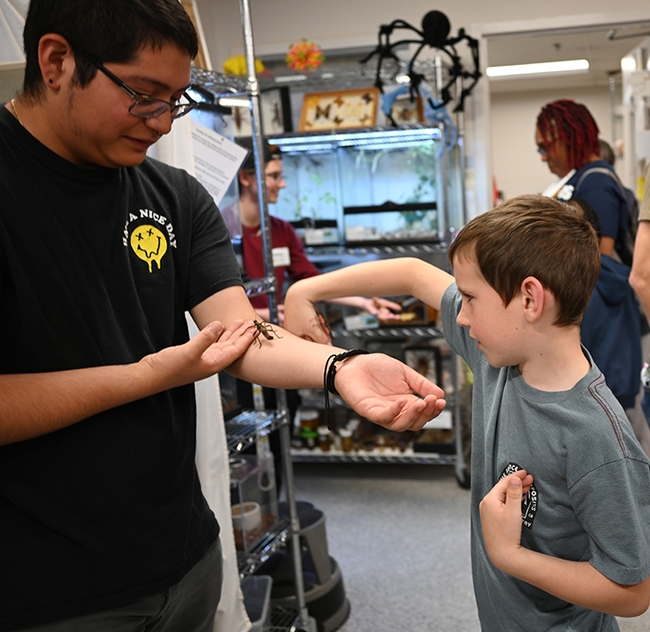
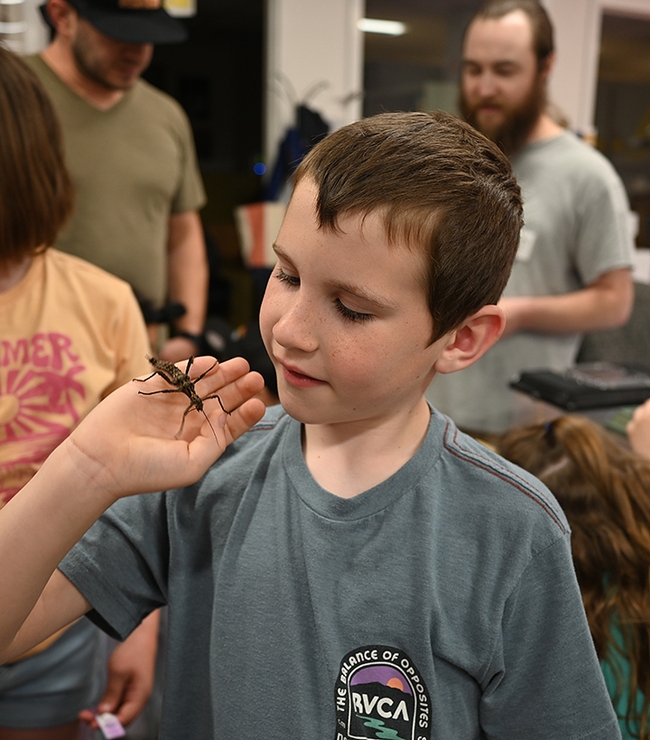
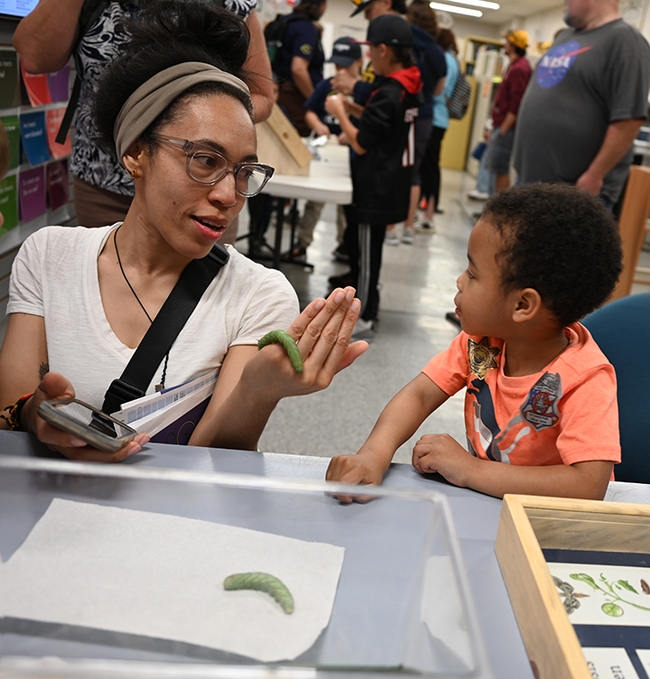

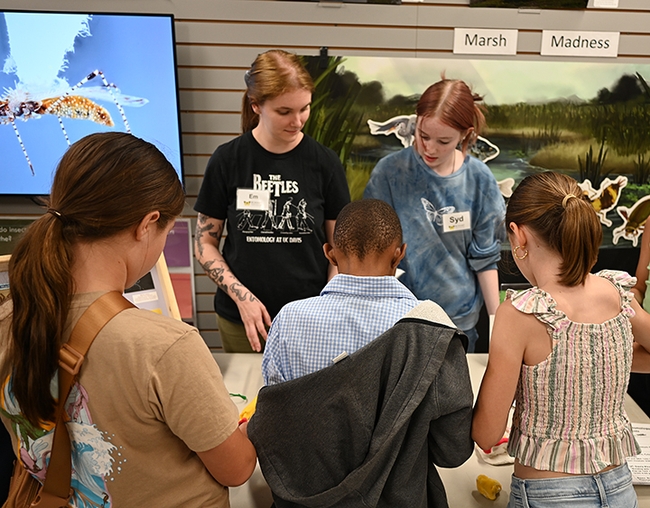
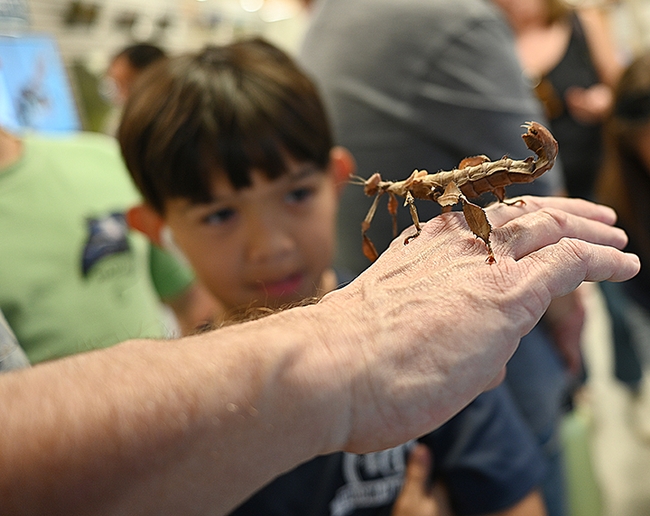
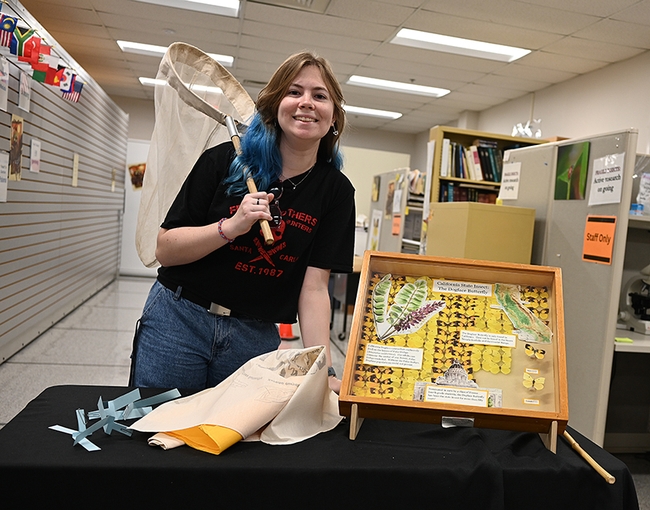
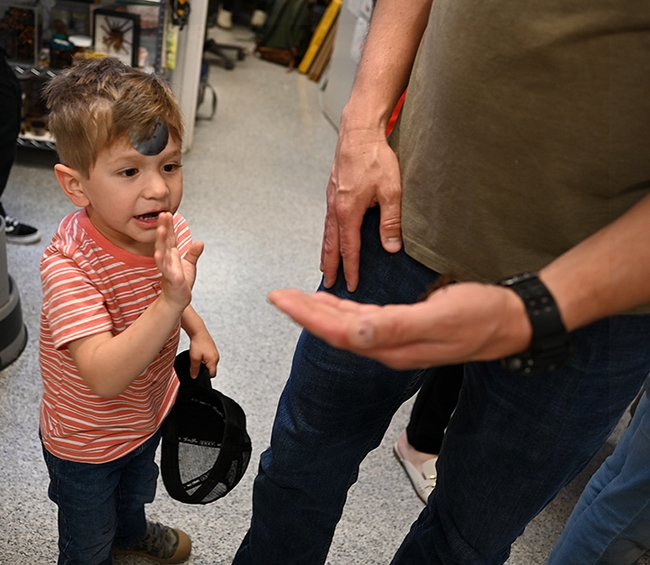
- Author: Kathy Keatley Garvey
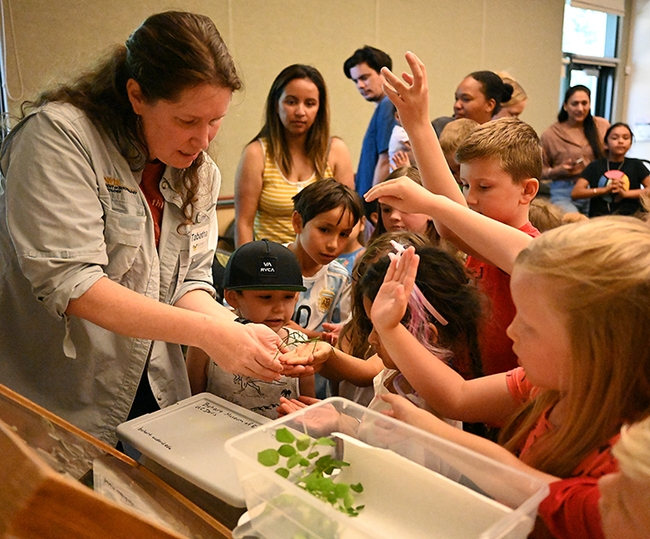
She's right at home with a "Oh, my drawers" of insect specimens, and the live critters in the petting zoo--the Madagascar hissing cockroaches, stick insects, tarantulas and more...She's eager to communicate science and draw interest in insects.
On April 29, Tabatha Yang was at UC Davis Chancellor Gary May's residence to accept the Chancellor's Outstanding Staff Award for Exceptional University Management and Exceptional University Impact with 11 other outstanding staff.
UC Davis distinguished professor emerita Lynn Kimsey, the 34-year director of the Bohart until her retirement on Feb. 1, accompanied her.
Sandy Batchelor, Human Resources WorkLife manager and awards committee chair, earlier said that Yang embodies "the spirit of engagement, innovation, and inclusivity that defines the university. With 15 years of dedicated service at the Bohart Museum, Tabatha spearheads a variety of educational initiatives aimed at demystifying and highlighting insects, spiders, science, and higher education."
"Through open houses, classroom visits, fairs, festivals, and other outreach programs, she helps the museum connect with more than 10,000 people each year. Under her leadership, museum walk-ins, tours and tabling events provide opportunities for students, staff and faculty to engage in science communication, highlight research and connect with others."
Yang annually chairs the committee that hosts UC Davis Biodiversity Museum Day, a “Super Science Day” that showcases 10 to 12 museums or collections and highlights UC Davis' research, collections and biodiversity, drawing thousands to campus.
She is also the founder and director of Bio Boot Camps, an immersive experience that ignites passion and curiosity in teenagers from around the globe. These camps, held annually since 2011, except during COVID, offer a gateway to the wonders of ecology, scientific exploration, and campus life. Campers tour UC Davis and its museums and collections and embark on scientific explorations of the UC Davis Putah Creek Riparian Reserve, Quail Ridge Field Station, Bodega Marine Laboratory and Bodega Marine Reserve and UC Berkeley's Sagehen Creek Field Station. With needs-based scholarships, Tabatha ensures inclusivity, making dreams a reality for aspiring young scientists.
Tabatha, a Cornell University alumna, shares her science educational background with her husband, community ecologist and professor Louie Yang, a Cornell alumnus who received his doctorate from UC Davis. He joined the UC Davis entomology faculty in 2009.
The list of recipients of the inaugural award:
Exceptional University Management
- Nichole Mahaffey, clinical trials data team supervisor and assistant director of PRMS, Comprehensive Cancer Center Office of Clinical Research
- Santana Diaz, executive chef, Food and Nutrition Services
- Morgan Luthi, director of curriculum and educational technology, Office of Medical Education
- Wendy Lilliedoll, director of investigations, Office of Compliance and Policy
- Shannon Tanguay, budget director, College of Agricultural and Environmental Sciences Dean's Office
- Jason Herum, diving safety officer, Bodega Marine Laboratory
Exceptional University Impact:
- Kelly Yurosky, pediatric bone marrow transplant coordinator, Pediatric Hematology and Oncology
- Abigail Borbe, senior clinical research coordinator, Pediatrics
- Leah Galasso, technical project manager, Clinical Informatics
- Bill Tuck, fiscal officer, Physics and Astronomy
- Elizabeth Sturdy, director of mentoring and Academic Success Initiatives, Graduate Studies
- Tabatha Yang, Bohart Museum education and outreach coordinator, Department of Entomology and Nematology
Meanwhile, Yang is busily planning, scheduling and organizing more outreach activities.
Next Open House. The next Bohart Museum open house is from 1 to 4 p.m., Sunday, May 19. The theme: "Bees, Both Wild and Managed." It will feature the research of university professors (more information pending). All open houses are free and family friendly.
The Bohart Museum is located in Room 1124 of the Academic Surge Building, 455Crocker Lane. Professor Jason Bond succeeded Kimsey on Feb. 1 as the Bohart Museum director. He is the Evert and Marion Schlinger Endowed Chair of the Department of Entomology and Nematology, and the associate dean, UC Davis College of Agricultural and Environmental Sciences. He also serves as president-elect of the American Arachnological Society.
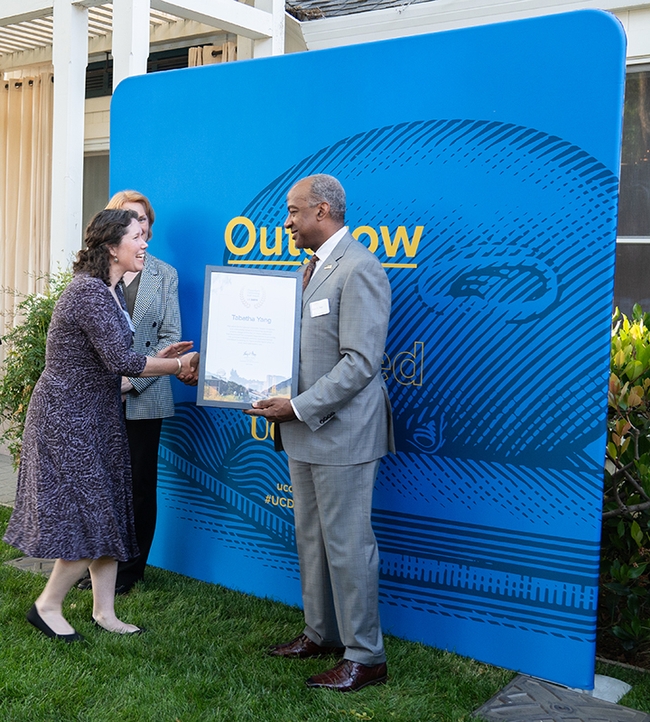
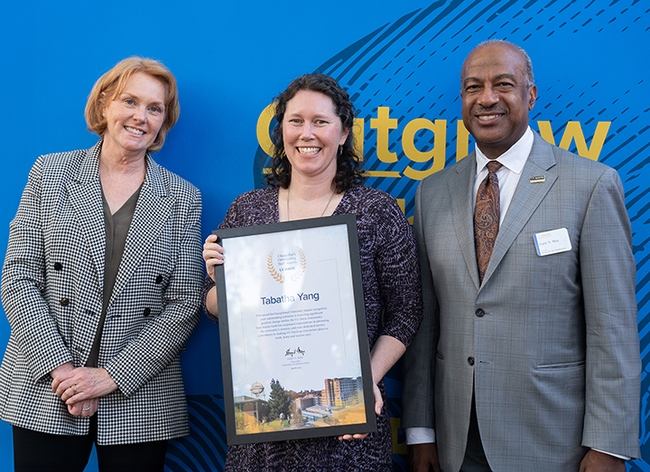
- Author: Kathy Keatley Garvey
"Super Science Day" at the University of California, Davis, is a day before the Super Bowl.
The 13th annual UC Davis Biodiversity Museum Day, set Saturday, Feb. 10, is a free and family friendly event showcasing 10 museums or collections.
What's to see? What's to do? Should you plan to attend all of them? What would interest toddlers, teenagers and senior citizens?
Tabatha Yang, who chairs the annual event and is a co-founder and serves as the education and outreach coordinator for the Bohart Museum of Entomology, provides the answers on the Biodiversity Museum Day website:
What is the best way to experience Biodiversity Museum Day? We would suggest picking several collections to visit this year and then return next year to see the others. We intend for people to spend time at each collection instead of racing between them.
I have a toddler. Which collections are suitable for this age group? The Arboretum is outside and a great space for young visitors to explore. The Raptor Center is also outside and has live birds to observe. The Bohart has live insects to pet and the Botanical Conservatory has plants everywhere, but their greenhouses have narrow aisles. Holding or carrying your toddler through the greenhouses is an enjoyable way to take in that collection.
I have a teenager. Which collections are suitable for this age group? Anthropology is open into the afternoon and they have flint knapping and atl-atl throwing. The Museum of Wildlife and Fish Biology is also a favorite as they deal with birds, mammals, fish and reptiles and amphibians. The Botanical Conservatory also has a great carnivorous plant collection.
Hidden gems? This is the one day the Phaff Yeast Collection and the Nematode Collection are showcased to the general public. They also have some of the smallest, but mightiest organisms. These scientists are so enthusiastic that you will want to become a microbiologist or a nematologist.
I will be visiting with 9-year-olds to 90-year-olds. Which collections are crowd pleasers? While all of them are, one can never go wrong with fossils at Paleontology and the pressed plants at the Center for Plant Diversity.
Where can we grab a bite to eat? The event map has some options for eating. The dining halls have a set fee and then it is all-you-can-eat. For your convenience there will be a few hot trucks at this event and you are welcome to bring your own food or explore Downtown Davis for other options.
Download the Map! Before you go on campus, download the map, which lists the location of the main information booth, the 10 museums and collections and their hours, the food locations (dining halls and food trucks) are, and the free-to-park parking lots. Sites that are grayed out on the map may not be free. TAPS (Transportation Services) controls the parking, which can be especially busy near the Mondavi Center for the Performing Arts at 523 Mrak Hall and the UC Davis Health Stadium, known as the football stadium, Health Sciences Drive.)
Here's the list of the 10 museums and collections and brief information from the spokespersons:
Anthropology Museum, noon to 4 p.m.
Located in 328 Young Hall and grounds.
"Anthropology is the study of what makes us human, and it includes understanding our evolutionary history from both a biological and a cultural perspective. Try your hand at flint knapping and learn how our ancestors made stone tools, or you can test your skills at spear throwing using an atlatl. Learn about prehistoric art from caves in France by making your own block print of the animal images. Then take a tour of our museum collections, and our biological anthropology and archaeology labs. Meet our paleoanthropologists and archaeologists working in Alaska, Germany, Belgium, France, South Africa, and Peru. Learn about our archaeological field school on historical cattle ranching."
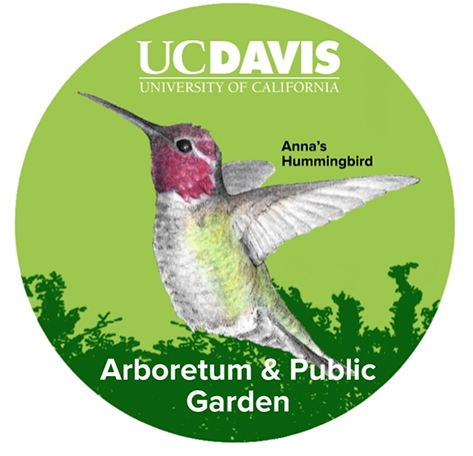
Habitat Gardens in the Environmental GATEway, adjacent to the Arboretum Teaching Nursery on Garrod Drive, open 10 a.m. to 2 p.m.
"Participate in the Meet Your Garden Neighbor personality quiz. Receive a sticker of your wildlife garden neighbor and search the garden for a partner plant that will support that neighbor. Participate in the Habitat Scavenger Hunt. Tour the garden to discover different ways we can provide habitat for urban wildlife in our gardens. Binoculars and hand lens available for observations."
Bohart Museum of Entomology
Room 1124 and main hall of the Academic Surge Building, 455 Crocker Lane, open 10 a.m. to 2 p.m.
"Home of a global collection of eight million insect specimens. Includes a live petting zoo (Madagascar hissing cockroaches, stick insects, tarantulas and more), and an insect-themed gift shop stocked with t-shirts, hooded sweatshirts, jewelry, books, posters, pens and insect collecting equipment. See the beautiful butterfly specimens from all over the world."
Botanical Conservatory
The greenhouses along Kleiber Hall Drive, open 10 a.m. to 2 p.m.
"The Botanical Conservatory houses approximately 4000 different species from all over the world. Included in the collection are carnivorous plants, succulents, tropicals including the corpse plant, and vanilla vine and chocolate tree."
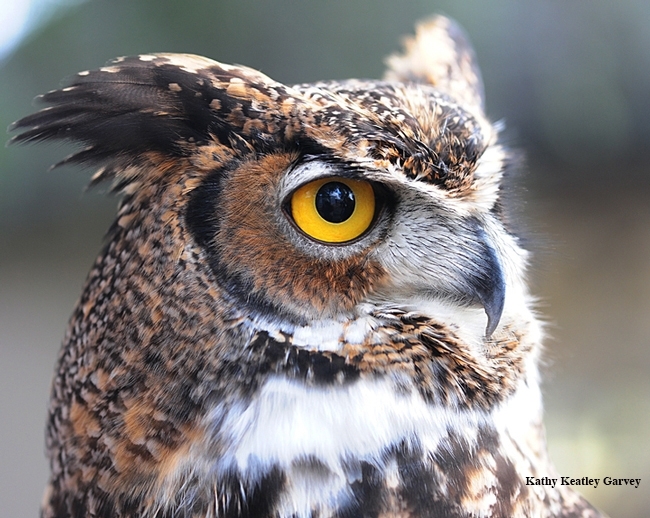
1340 Equine Lane, off Old Davis Road, open 9 a.m. to 3 p.m. (three miles away from central campus)
"Our non-releasable ambassador raptors can be seen on exhibit, and several of our glove-trained ambassador raptors will be out with their handlers throughout the day. Visitors will have the opportunity to see multiple native raptor species up close and talk to our experts. We are happy to answer questions about birds of prey! Our small on-site museum will also be open with taxidermy specimens and interactive raptor-related activities."
Center for Plant Diversity (Herbarium) Katherine Esau Science Hall off Kleiber Hall Drive, open 10 a.m. to 2 p.m.
"We will have plant pressing and mounting demonstrations, looking at flowers under a microscope, an exhibit on plants used for making tea, and collection room tours."
Nematode Collection, Katherine Esau Science Hall, off Kleiber Hall Drive, open 10 am. to 2 p.m.
"We will have preserved specimens of common crops and plants you see in your garden infected with nematodes. We also plan to have live C. elegans to watch how they move through the environment. Come talk to experts in the field and see why worms are cool and you will receive a cool magic worm to take home as well! Our collection will highlight both animal and plant parasitic nematodes,” said graduate student Alison Blundell of the Siddique lab. “We will have mostly all preserved specimens from our nematode collection for the community to look at, and some live free-living (good nematodes) under the microscope for viewing. We hope to inspire people to understand what a nematode is and how they can impact their own lives!"
Museum of Wildlife and Fish Biology, Room 1394, Academic Surge Building, 455 Crocker Lane, open 10 a.m. to 2 p.m.
"We are offering an in-depth behind-the scenes look at how a specimen goes from a whole carcass to cataloged specimen. Museum staff and interns will be demonstrating specimen preparation curation, cataloging, and bone numbering. A variety of specimen types will be on display and there will be some exhibits with specimens in the main hallway for visitors to enjoy and explore with ourPutah Creek biologists and docents."
Paleontology Collection, Department of Earth and Planetary Sciences, 1309 Earth and Physical Sciences Building, 434 LaRue Road, open 10 a.m. to 2 p.m.
"Visitors can view fossil specimens dating from as old as 550 million years ago to more recent animal skeletons. Paleontology graduate students in invertebrate and vertebrate paleontology will answer questions and provide interesting factoids."
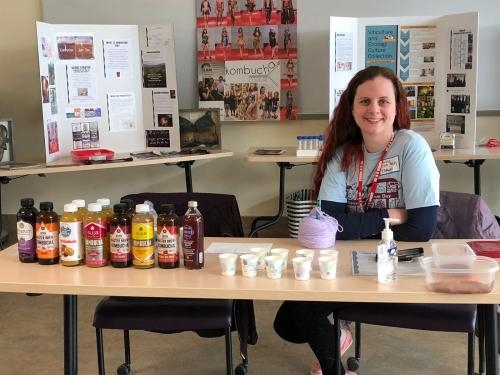
"The Phaff Yeast Culture Collection exhibits will be in the Brewery, Winery and Food Processing (BWF) facility. Come hear about our latest discoveries using more than 1,500 yeast species in the Phaff collection, see and smell many species of yeast, look at yeasts under the microscope, taste kombucha and vegemite, tour the teaching winery and the teaching brewery, and talk with students and scientists who are maintaining and performing research using this world-famous yeast collection. Parking is available in the lots near the Mondavi Center, and signs will direct you to the BWF building."
Special prizes: Jakob Lopes, a third-year animal major at UC Davis and a Bohart intern, will be making 15 to 20 crocheted triceratops and hide them around some of the buildings for folks to find and treasure. A tag reads: "CONGRATS, you found me. Now please take care of me.--Happy Biodiversity Day 2024."
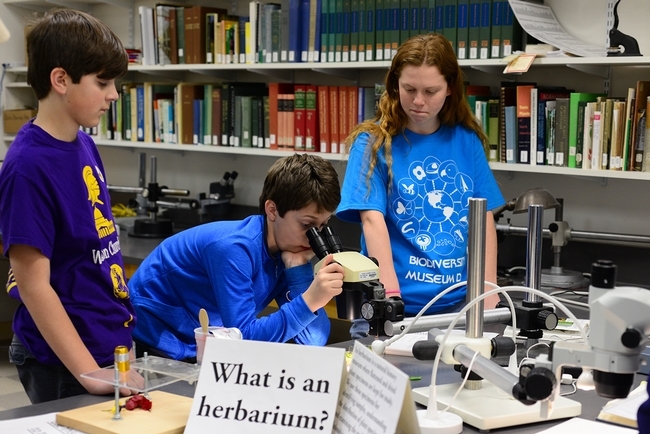
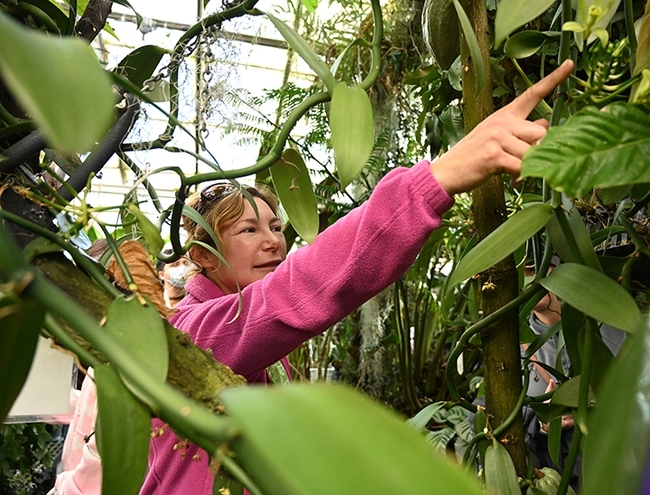
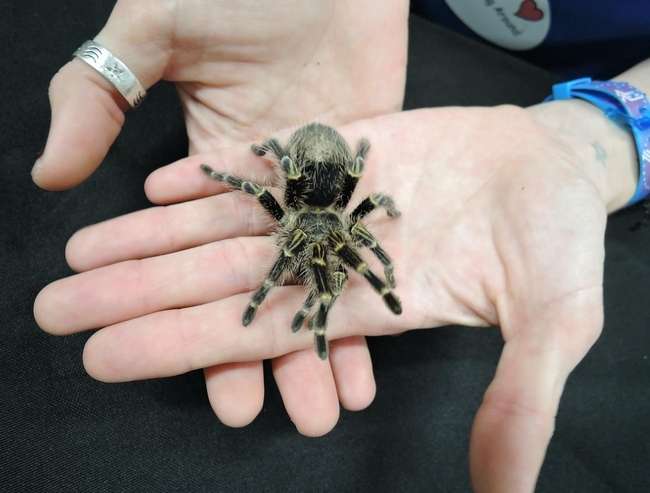
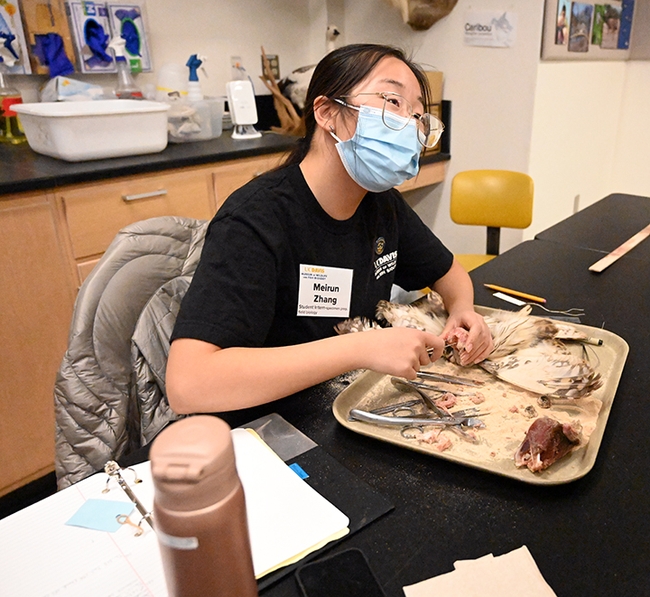
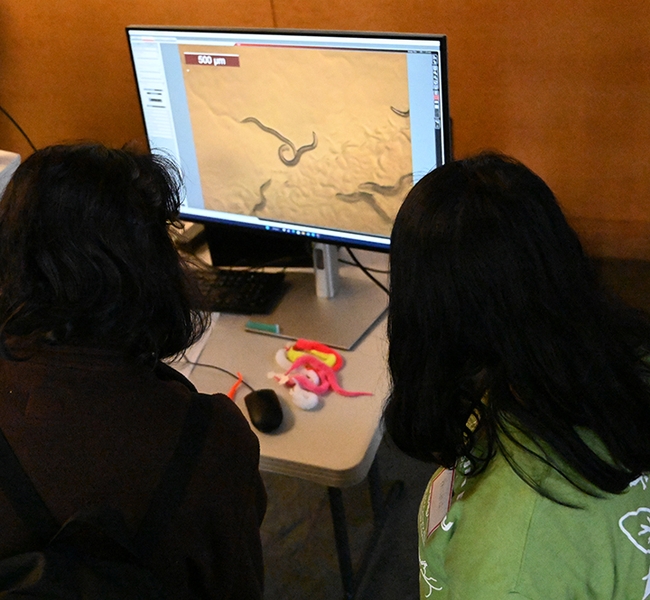
- Author: Kathy Keatley Garvey
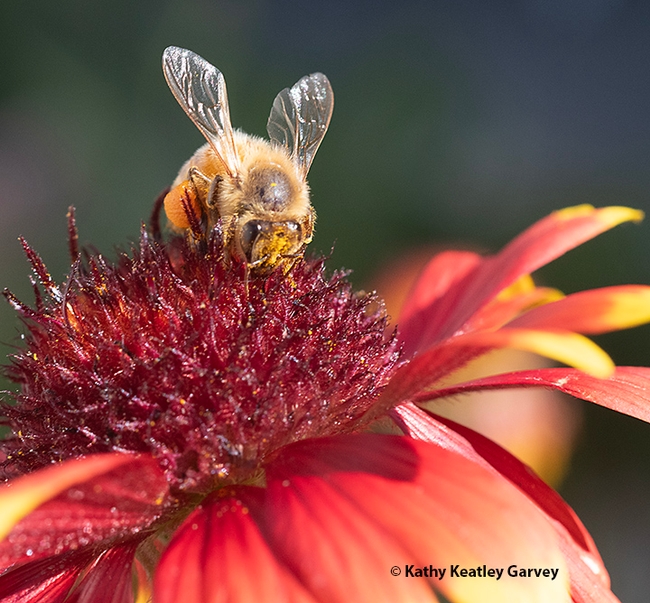
You can visit UC Davis museums or collections, talk to the scientists, and learn more about what makes UC Davis an internationally known science-based university. The free-and-family-friendly event, set Saturday, Feb. 10, features 10 museums or collections. It's a Super Science kind-of-day, and one you won't want to miss!
Your preferred choice transportation will involve your feet (walking) or wheels (bicycle and car to get to campus and the California Raptor Center on Old Davis Road). It won't be the double-decker bus in the graphic below. But isn't it cool? Each of the museums or collections is represented by a passenger on the bus.
Behind the scenes: In 2020, UC Davis biology laboratory manager (and talented artist) Ivana Li was asked for a graphic to help publicize the event, and she came up with a double-decker bus featuring the participating museums and collections. Fast-forward to this year and Caitlen Comendant, an undergraduate design major at UC Davis, and a media intern for the Center for Plant Diversity and the Botanical Conservatory, colorized the graphic and updated it.
In 2022, we wrote this about the double-decker bus: "All aboard! C'mon in, Ms. Salt Marsh Harvest Mouse. Don't sit too close to Mr. Golden Eagle. Buzz in Ms. Honey Bee. Stay away from Mr. Chinese Praying Mantis, Tenoderasinensis. Sorry, but the driver can neither guarantee your safety nor your arrival at your intended destination."
This year all 12 passengers kept their seats, but the event now features 10 museums and collections instead of 12. Not participating this year are the UC Davis Bee Haven (represented by the honey bee) and the Marine Invertebrates Collection (represented by a California sea cucumber).
The passengers depicted, upper level (from left)
- California Raptor Center: Golden eagle
- UC Davis Arboretum and Public Garden: Valley oak leaf
- Anthropology Museum: Projectile point
- Botanical Conservatory: Titan arum
- Phaff Yeast Collection: Budding yeast
- Paleontology Collection: Skull
Lower level (from left)
- Bohart Museum of Entomology: Chinese praying mantis, Tenodera sinensis
- UC Davis Bee Haven: honey bee
- Museum of Wildlife and Fish Biology: Salt marsh harvest mouse
- Nematode Collection: Hookworm
- Center for Plant Diversity: Seed cone of a gray pine
- Marine Invertebrates Collection: California sea cucumber (included on bus but this collection will not be included at the Biodiversity Museum Day)
So, is bee is declared safe from the praying mantis? They're still on the bus. (No flora or fauna got eaten or thrown under the bus.)
The 10 museums or collections participating on Feb. 10 and the hours open are:
- Anthropology Museum, 328 Young Hall and grounds, open from noon to 4 p.m.
- Arboretum and Public Garden, Habitat Gardens in the Environmental GATEway, adjacent to the Arboretum Teaching Nursery on Garrod Drive, 10 a.m. to 2 p.m.
- Bohart Museum of Entomology, Room 1124 and main hall of the Academic Surge Building, 455 Crocker Lane, 10 a.m. to 2 p.m.
- Botanical Conservatory, the greenhouses along Kleiber Hall Drive, 10 a.m. to 2 p.m.
- California Raptor Center, 1340 Equine Lane, off Old Davis Road, 9 a.m. to 3 p.m.
- Center for Plant Diversity, Katherine Esau Science Hall off Kleiber Hall Drive, 10 a.m. to 2 p.m.
- Nematode Collection (part of the UC Davis Department of Entomology and Nematology), Katherine Esau Science Hall, off Kleiber Hall Drive, 10 am. to 2 p.m.
- Museum of Wildlife and Fish Biology, Room 1394, Academic Surge Building, 455 Crocker Lane, 10 a.m. to 2 p.m.
- Paleontology Collection, Department of Earth and Planetary Sciences, 1309 Earth and Physical Sciences Building, 434 LaRue Road, 10 a.m. to 2 p.m.
- Phaff Yeast Culture Collection, Robert Mondavi Institute Brewery and Food Processing facility, Old Davis Road, 10 a.m. to 2 p.m.
Last year some 4,000 visitors learned "about biodiversity through our amazing biological collections," said UC Davis Biodiversity Museum Day chair Tabatha Yang, education and outreach coordinator for the Bohart Museum of Entomology.
